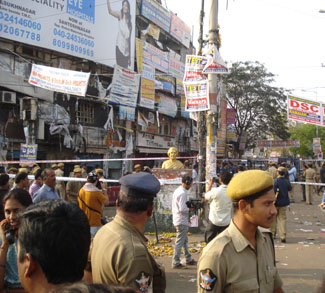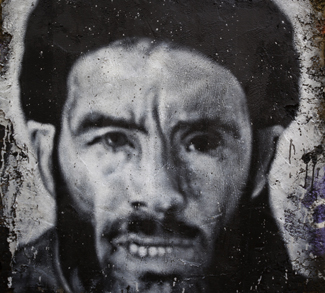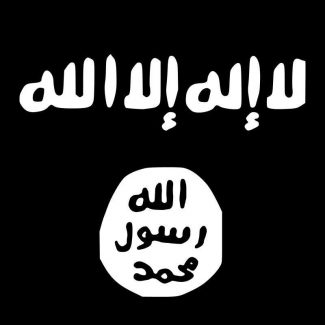The recent arrest of Yasin Bhatkal, founder and one of the top leaders of an Indian terror group, Indian Mujahideen (IM) along with the arrests of key IM operatives, Fasih Mohammed (deported from Saudi Arabia 2012) and Abdul Sattar, a key facilitator (deported from the UAE in August), has been touted as a deadly blow to Islamic terror groups and even more so to the Indian Mujahideen.
These arrests are considered to be a major breakthrough for the Indian intelligence agencies, given the invaluable information Yasin Bhatkal and his associates could provide about the functioning of IM and its sleeper modules in India.
Yasin Bhatkal along with his siblings Riyaz and Iqbal have been instrumental in inspiring, planning, funding, and recruiting youngsters to carry out these attacks. IM has been known to have carried out bomb attacks on major Indian cities from 2006. It is suspected to have been behind atleast twelve bomb attacks across India. A recent blast in Hyderabad is also suspected to be the handiwork of IM.
An analysis of open source publications indicate that Yasin Bhatkal is considered to be the key bomb maker, explosives supplier, recruiter and a key financial facilitator of IM using fake Indian currency notes (FICN).Given his position in the higher echelons of the organization and his in-depth knowledge of the various sleeper modules in India, there is little doubt that this would be a fatal blow to IM.
It is already reported that there are around 5 contenders to succeed Yasin Bhatkal as IM head in India. One of the following would be the most probable member to step into Yasin Bhatkal’s shoes: Shahnawaz Alam, Muhammad Sajid Bada, Alamzeb Afridi, Fayaz Kagzai or Ariz Khan.
However, given the above succession plan, and judging by the survival of IM during similar setbacks earlier, it would not be prudent to assume that this arrest will actually impact the operational efficiency of the IM. Previous arrests of key IM members like Thadiyantevide Nazir seem to have had little or no impact on IM’s operational effeciency.
Thadiyantevide Nazir, a key IM operative who was very active in southern India, was handed over by Bangladesh to India in 2009. He is alleged to be the brain behind recruitment and subsequent attempts to smuggle eight youngsters from Kerala to Pakistan. Four of them were gunned down in Kashmir during the ex-filtration bid in 2008. According to the special investigation team (SIT), Nazir was one of the key operational members of IM, active in southern India and suspected to be behind terror attacks at Ernakulam Collectorate, (Kerala,2009), Coimbatore Press Club (Tamilnadu,2008) and the Bangalore terror attacks (Karnataka, 2008). His arrest has not had a serious impact on the IM’s ability to carry out terror attacks, as he had already trained atleast a dozen recruits in bomb making. The very fact that IM has been able to successfully and consistently conduct major terror attacks across Maharashtra, Uttar Pradesh, and Andhra Pradesh (seven attacks from 2009-2013) even after the arrest of Nazir stands as ample testimony to the strength and ability of IM to regroup easily.
The very basic fabric on which the organization is built lends itself to an ability to survive, prolong and regroup, which extends its longevity and breadth. Inherent strengths such as organizational structure, diversified funding sources using alternative remittance systems, membership constituted by indigenous populace, and links to organised criminal gangs play very important roles in IM’s future sustenance and survival.
First and foremost in determining a group’s survivability is its organization. The organizational structure of a terror group determines its resilience. Terror organizations are structured as either hierarchical or networked. A typical hierarchical terror organization will be managed by its leader or collective leadership that take decisions and ensure support to the operational modules. The leadership would provide motivation, money and material support to the operational modules. The structure of the organization is similar to a pyramid with its central leadership vertically at the top and its functions arranged horizontally below. This type of structure is conducive for carrying out complex terror operations which require impeccable coordination between its members. However, since it requires constant interchange of communications and support, it is highly prone to disruption and hence very vulnerable.
A networked structure on the other hand, is much flatter and laterally organized. A further variant of a networked structure is called virtual networks, where individuals initiate action on their own, supported by self sufficient funds, creating their own logistical base. The advantage of a virtual network is manifold. Minimal or reduced communication between members of the virtual network during the planning stage of an operation renders it very difficult for intelligence agencies to disrupt. A virtual network also facilitates development of second-level leaders. In this manner, members of localized modules are elevated to leadership level overnight when key leaders are removed.
Hence, removal of its leaders would be more pronounced in a hierarchical setup compared to networked setup. However, conventional wisdom and a closer scrutiny of other hierarchically organised terror groups such as Al Qaeda and its affiliates, suggest greater resilience and sustenance post-removal of their leaders recently. In August this year, 19 embassies of the United States were shutdown temporarily across Middle East, Africa and South Asia due to credible threat emanating from Al Qaeda and its affiliate organizations. This advisory which comes two years after Al Qaeda leader Osama bin laden was eliminated is an ample testimony to the fact that removal of leaders or important operatives does not necessarily have a greater impact, even on a terror organization that is arranged hierarchically.
Al Qaeda experts Mr. Rohan Gunaratna and Mr. Aviv Oreg state that Al Qaeda consistently has been able to replace leaders who were either killed or captured. They also point out that Al Qaeda has lost four chiefs of staff, four chiefs of the special forces unit, and at least half a dozen senior regional field commanders from 2003-2012. This is a result of evolving terror organization having a hierarchical setup at its super structure level and networked setup at its lower modules. This is the new hybrid organizational structure which is currently being followed by groups waging asymmetrical warfare globally, and in this IM is no exception.
In case of IM, though originally conceived as a hierarchical organization, it presently functions as a networked organization atleast at the operational module level. The local module consists of 4-8 members and is managed by a team leader known as Tabiryate amir. The amir alone communicates with the top leadership based outside India. Each of these modules is independent and functions in a virtual network environment. Hence, any arrest or removal of key leaders outside the network will have little desired impact. Moreover as virtual networks are built to create second-rung leaders, any vacuum created by the removal of a key leader or operative is filled automatically. This new hybrid structure is one of the key advantages for survival of IM.
The second determiner of a group’s survivability is its sources of finance, and in extension the modus operandi used to move them. Terror groups derive their financial muscle from both legal and illegal sources, transferring and moving this ill-gotten money using both formal and informal financial channels. A terror group’s funding allocation is normally skewed heavily in favour organisational expenses (costs associated with infrastructure, training, weaponization, safe houses, and day-to-day expenses) compared to the operational component (costs associated with planning and execution of terror attacks). The usage of different sources for different end use of funds makes it more difficult for agencies to interdict these funds.
IM organizational infrastructure within India is said to be very modest. Hence any cost associated with this aspect is lower. However, considering the quantum of funding received in Gulf countries, most organisational cost goes into preserving this revenue stream outside India. Hence any cross-border movement of funds takes place only for operational purposes, and mostly through Hawala, an informal money transfer system.
It has been ascertained from interrogation reports of key IM operatives that the operational cost of terror operations in India has been funded by their operatives based in Pakistan and Saudi Arabia using Hawala. Given India’s size of expatriates’ population in Gulf and its reliance on Hawala for genuine purposes like family maintenance, it would be highly difficult to monitor and regulate such a system. Thus, interdiction of operational funds would be highly difficult.
Recent reports indicate that IM have taken to criminal activities and established links with organised criminal gangs to support and fund its activities in India. IM members have been asked to take to arms trafficking, as well as robbing jewelry stores and banks to fund their operations. According to the Madhya Pradesh Anti-Terror Squad (ATS), an IM module had robbed five banks in Dewas, Itarsi and two other places in the Madhya Pradesh. The same module is also responsible for robbing 13.5 kgs of gold from the Mannapuram Gold Finance Company. The crucial factor is that these funds were raised to fund organisational costs.
Reliance on outside funds through Hawala for operational purposes and domestic self raised funds for organisational purpose reveal a clear intent to have a diversified and a perennial funding source very hard to interdict. This necessarily results in a diminished cross border movement of funds. This strategy reveals that IM is attempting to achieve self-sufficiency in funding which could give them more autonomy, and make their funding networks less vulnerable to detection.
It is also important to consider that the constitution or membership of a terror group defines the character and colour of the movement. A group consisting of indigenous population stands a better chance of survival compared to a group consisting of foreigners. Locals can blend in easily and will also derive logistical support from local support communities which are sympathetical to their cause.
Unlike other Islamic terror groups in India like Lashkar-e-Taiba, IM’s foot soldiers are Indian citizens drawn from different parts of India. Yasin Bhatkal has been instrumental in building sleeper cells across India in the last five years. Sleeper modules have been known to exist in Maharashtra, Uttar Pradesh, Bihar, Andhra Pradesh, Karnataka, New Delhi, Tamilnadu, and Kerala. These cells are predominantly constituted of young men aged from 20-22. While the young operatives are motivated by money, relatively older members are driven by ideology. Another variant of membership is integration of an outside group or a module with IM.
Interrogation reports of IM operatives belonging to Karnataka module and Nanded module reveal that these cells were formed by local youths with a localized objective in mind. These groups were formed to assassinate prominent politicians, businessmen and journalists. Members of both these modules did not have prior direct connection or affiliation to IM leadership or operatives. However, both modules became integrated into the IM network once there was a convergence of interests. The cells needed more funds to achieve their objective while the IM needed foot soldiers to carry out terror attacks.
Similarly, IM became entwined with organized criminal syndicates for operational purposes. Thus, members of the organised criminal gangs assumed the membership of IM. A classic example would be the case of Aftab Ansari, a key mastermind of the American center attack in Kolkata in 2002 who was deported from United Arab Emirates in 2002. He was a key member of Asif Raza Commando Force named after the head of an organised criminal leader known by the name Asif Raza Khan. This outfit which was floated by Amir Raza Khan, brother of Asif Raza Khan merged with IM later. Amir Raza Khan is currently the financier for IM and based out of Pakistan. This outfit led by Aftab Ansari in India ran a Kidnap for Ransom (KFR) industry. Aftab Ansari was involved in the kidnapping of Kolkata businessman named Partho Burman Roy tab Ansari in July 2001. It is noteworthy that around USD 100,000 (Rs.48 lakh) of Rs.3.5 crores which was paid as the ransom amount, was diverted by Ansari to Mohammed Atta, head of the World Trade Center attackers through Omar Sheikh.
Riyaz Bhatkal, brother of Yasin Bhatkal started as a small time criminal before indulging in terrorist activity. Interrogation reports of IM operatives belonging to Pune module which carried out the 2012 serial blasts in Pune indicate that, the team purchased pistols from a local organised criminal gangster for Rs.70, 000. IM also ran an illegal arms factory in Delhi to fund its operations and also increase the illegal proliferation of arms. Mutually beneficial linkages like these established common platforms where the IM used the network and members of organised criminal groups to facilitate and support the operational modules during terror attacks. Linkages like these lured the greedy criminal members into a more active role than a passive role inside IM. Criminal gangs peddling FICN operating from and outside India’s Eastern borders are known to have linkages with IM.
Conclusion
IM has been in existence since 2005. Unlike other terror organizations in India, IM has been able to function without any major infrastructure and facilities. The very fact that it has been able mount repeated attacks inside major Indian cities despite its skeletal organizational base is an ample testimony to the operational efficiency of the group. The organizational growth of IM is presently in a stage where the membership, funding and structure have evolved from its original form. Yasin Bhatkal’s arrest would have had a greater impact if it had happened much earlier when the organization was still in the stage of infancy. However, yet it is still vulnerable but relatively placed better in terms of self sufficiency in funding, local membership and establishing infrastructure inside India. A major concern for policy planners is IM’s ability or the attempts to set up infrastructure inside India.
Notwithstanding the abovementioned, IM could lie low initially for a short period but would attempt to conduct a spectacular attack to announce their resurgence. Law enforcement agencies could witness greater resilience from IM in years to come. Due to the growing indigenous content in its membership, IM would be able to mount operations in the heart of the country more easily rather than its periphery. But once a module is neutralized, another entirely different group without any connection might surface as a different entity in the same place. Hence, the impact of these arrests on IM will be ephemeral rather than eternal.
There is an uncanny similarity with Al Qaeda and a sense of déjà vu when it comes to Indian Mujahideen. Marc Sageman, a renowned terror expert, states that Al Qaeda’s recruitment process after 9/11 changed dramatically: “After 9-11, the whole network changed completely. There is no recruitment, really. In my sample, I have found no case of a recruiter. They’re all volunteers.” The IM recruitment cycle is in a similar stage where most of its members are voluntarily attracted rather than forcibly recruited. Increased discovery of new cells in hitherto unknown and less affected parts of India like Tamilnadu support this theory. Regardless of the motivation, the real concern should be the deep radicalization of youngsters in the urban centers of India. In the end, IM could be an Indianised version of groupings under New Terrorism which are characterized by a flat structure, self sufficient funding, localized recruitment and operations aided by technology.
In a way, by integrating external modules and members of organised criminal groups into its fold, an analogy can be drawn between IM and Al Qaeda. IM’s organizational transformation and its relations with external modules are akin to Al Qaeda’s relations with its affiliates. The convergence of interests, degraded operational capability of Al Qaeda, IM’s operational linkages to other terror groups like Lashkar-e-Taiba and Jaish-e-Mohammed, as well as its resilience places IM as one of the potential candidates of an Al Qaeda affiliate in the making.




